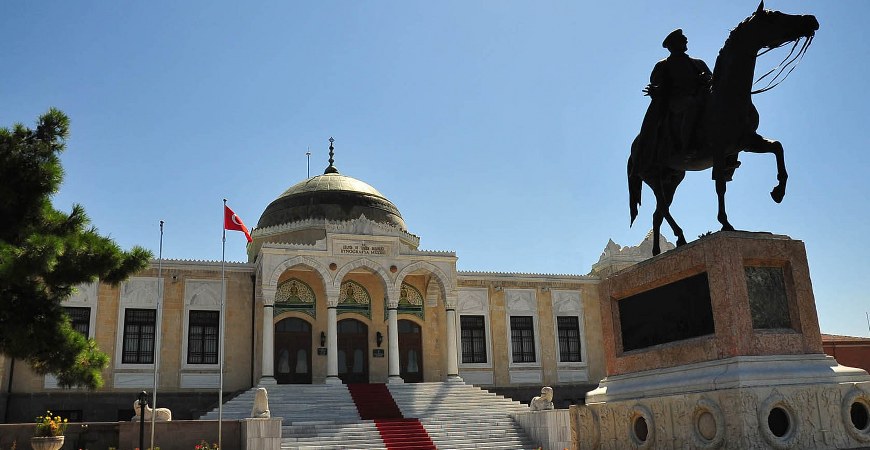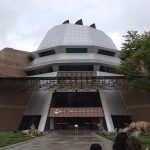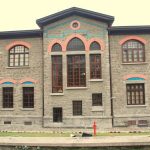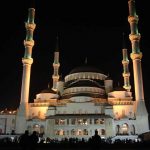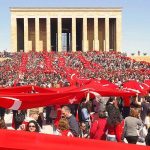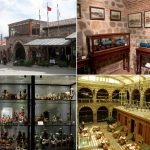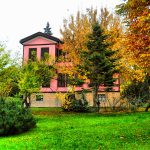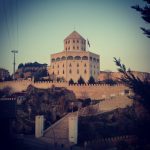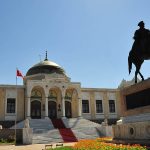The Ankara Ethnographic Museum
One of the first museums established during the period of the Turkish Republic. Construction of a National Museum was begun in 1925 on the recommendation of the Hungarian Turkologist, Meszaros, and completed in 1927. It was opened in 1930 as the Ethnographic Museum, containing examples of ethnography and Turkish art from Anatolia. The museum gradually grew in scope and size, and now consists of 10 halls, a library, an archive, store rooms and administrative offices. The halls are arranged in sections as follows: Entrance Hall of Honour: The entrance to the museum consists of a large domed hall. After his
Entrance Hall of Honour: The entrance to the museum consists of a large domed hall. After his death, Ataturk was temporarily buried here between 1938 and 1953. A marble plaque reading “After his death on 10.11.1938 Ataturk rested here from 21.11.1938 to 10.11.1953” marks the place where he was buried. There are a bronze bust and pictures of Ataturk in the Hall of Honour.
One of the first museums established during the period of the Turkish Republic. Construction of a National Museum was begun in 1925 on the recommendation of the Hungarian Turkologist, Meszaros, and completed in 1927. It was opened in 1930 as the Ethnographic Museum, containing examples of ethnography and Turkish art from Anatolia. The museum gradually grew in scope and size, and now consists of 10 halls, a library, an archive, store rooms and administrative offices. The halls are arranged in sections as follows:
Entrance Hall of Honour: The entrance to the museum consists of a large domed hall. After his death, Ataturk was temporarily buried here between 1938 and 1953. A marble plaque reading “After his death on 10.11.1938 Ataturk rested here from 21.11.1938 to 10.11.1953” marks the place where he was buried. There are a bronze bust and pictures of Ataturk in the Hall of Honour.
Clothing Room: In this section are displayed jewelry, women jewelry ess, barber’s equipment, sandals, and Turkish peasant clothing from different areas of Anatolia.
Embroidery Room: Here can be seen examples of Turkish hand work, such as handerchiefs, waistbands, napkins, purses, bed covers, socks, and hamam sets. Anatolian kilims are hung on the walls.
Tapestry Room: Here are examples of the art of weaving in Anatolia. There are carpets and kilims from Gordes, Kula, Bergama, Yoruk, Mucur, Konya, Ladik, and Usak, dating from the Ottoman period, and examples of cloth from the Ottoman period, including velvet brocades, a serge loom and instruments…
Hall of Crafts: Here are exhibited examples of Anatolian copper craftsmanship : copper trays, pans, dishes, brass braziers, lanterns, kettles and sefertas (many-sectioned picnic boxes). There are also typical Anatolian tables (without legs), knives etc.
Ankara House: This is the room of an Ankara house dating from the eighteenth century, fully furnished with a decorated ceiling, shelves, an oven, cupboards, a sofa, flooring, a lamp and a mirror etc. There is also a model of a woman doing embroidery, and a man standing, dressed in the clothes of an Ankara infantryman.
Corridor: In one section there are kitchen utensils, ceramics from Canakkale, dumb-bells, maces, sets of harness, an arrow box and smoking sets. In the other section are examples of tiles from the Seljuk and Ottoman periods, glass objects, and Chinese and Japanese porcelain.
Hall of Objects from Tekkes (dervish retreats): This section includes objects removed from the tekkes of dervish orders, such as the Bektasi, Mevlevi, Bayrami, and Rifai, after their closure.
Hall of Besim Atalay: Objects donated by the well-known scholar, Besim Atalay, to the Ethnographic Museum. They include books, inscriptions, writing sets, coins, weapons, kitchen utensils, candlesticks, incense holders, lamps, decorated drawers, tiles, glass, a collection of keys and locks, and examples of carpets, kilims and tapestries.
Hall of Written Works: Exhibited in this hall are manuscripts, inscript-ions, books and decorated volumes of the Koran, edicts and letters from the Ottoman period, medals and medallions, writing sets used by callig-raphers, examples of the writing of famous Turkish calligraphers, ins-criptions and miniatures.
Hall of Wood Carving: Masterpieces of wood craftsmanship from the Seljuk, Beylik, and Ottoman periods, including pulpits, altars, carved tombs, door and window frames, lecterns, and the Seljuk throne. There are also examples of Seljuk and Ottoman wall tiles from Iznik and Kutahya. The Library of the museum and the archives containing the Records of the Canoncial Court are also of great value.

